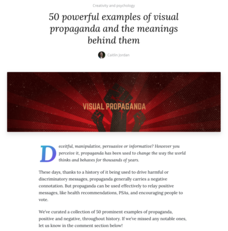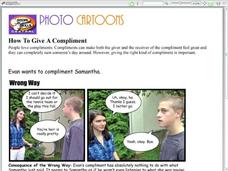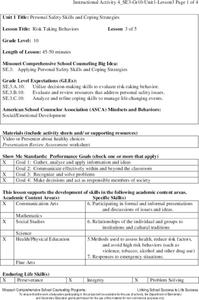Missouri Department of Elementary
Healthy Touches and Private Touches
Scholars identify the difference between healthy touches and private touches. A discussion leads pupils to recognize several trusting adults. Peers role-play scenarios in which they use three rules to remain safe.
Healthy Native Youth
Chapter 5: Learning About HIV/AIDS/STI's and Hepatitis Transmission
Middle schoolers delve deep into facts about HIV, AIDS, Hepatitis, and other STI's by way of discussion and a hands-on activity. Scholars ask and discuss questions anonymously using a Question Box. Two experiments showcase the...
Health Smart Virginia
"SuperBetter" Stress Management
The goal of this Health Smart lesson is for freshmen to develop a personal system for coping with stress. They create a power-up list of things that make them feel happier, healthier, or better connected, identify people in their lives...
K20 LEARN
Being Mindful Of Sadness In "The Scarlet Ibis": Theme And Characterization
James Hurst's short story "The Scarlet Ibis" provides readers with an opportunity to consider how they can support others who are experiencing distress. Participants learn self-care tips and connect to the short story's characters. They...
Nemours KidsHealth
Peer Pressure: Grades 3-5
Peer pressure is the focus of a lesson that challenges scholars to respond to several scenarios using responsible-decision making skills. Lesson one begins with a live-action example set by class members, followed by a discussion that...
Florida Department of Health
Understanding the Risk of Substance Abuse Unit
Teenage brains are different! Understanding that the teenage brain is still developing and thus more impacted by substance abuse is the key concept in a three-lesson high school health unit. Participants learn about how the brain and...
Nemours KidsHealth
Depression: Grades 9-12
Class members learn how to identify common signs of depression, as well as read articles on the origins and effects of this serious condition. The resource includes some great suggested activities for how learners can inform others about...
Council for the Curriculum, Examinations and Assessment
Relationships and Sexuality
The activities and discussions in this—the ninth in a series of 10 resources on Social, Physical, Emotional, Cognitive and Spiritual (SPECS) health—focuses on helping class members develop appropriate and healthy relationships....
Council for the Curriculum, Examinations and Assessment
Drugs Awareness
The final lesson in a series of 10 focusing on Social, Physical, Emotional, Cognitive and Spiritual (SPECS) health investigates the effects of legal and illegal substances, their risks, and the consequences of their misuse.
Canva
50 Powerful Examples of Visual Propaganda and the Meanings Behind Them
Propagandists have many tools at their disposal to influence thinking and behavior. Among the most powerful are the visual tools, posters designed to grab the attention and stir the emotions of viewers. Check out this collection of...
Texas Education Agency (TEA)
Just Chill: Don’t Stress Out!
Billy Joel's song, "Pressure," opens a lesson that teaches some techniques to deal with pressure and stressors, significant factors that contribute to aging and poor health. Throughout the four-day lesson, participants study stress...
Nemours KidsHealth
Suicide Prevention: Grades 9-12
The teenage years are tough. Internal and external pressures lead 1 in 15 high schoolers to attempt suicide. Two activities focusing on suicide prevention provide class members with information about when and how to get help for...
Nemours KidsHealth
Cyberbulling: Grades 6-8
Cyberbullying is the focus of two lessons. First, scholars discuss what cyberbullying is, and examine a problem-solving approach to handling cyberbullying, then create brochures on the topic. Second, pupils discuss the effects...
Social Skills Central
Photo Cartoons: How To Give A Compliment
Help learners develop the ability to offer appropriate, meaningful compliments to others—an essential social skill. Here you'll find a quick photo cartoon illustrating a right and wrong way to give a compliment, as well as a brief...
Nemours KidsHealth
Bullying: Grades 9-12
Scholars learn to shut down the rumor mill by asking three questions: "Is it kind?" "Is it true?" "Is it necessary?" in an 11-page packet that details three activities designed to make a difference at your school. Here, pupils run for...
Nemours KidsHealth
Cyberbullying: Grades 9-12
A bully, a victim, and a bystander—far from the beginning of a joke, cyberbullying is no laughing matter. Bystander or upstander? As part of the study of cyberbullying, high schoolers first read a series of articles about cyberbullying...
Nemours KidsHealth
Empathy: Grades K-2
Second graders read articles about being afraid, dealing with anger and apologizing. In this feelings lesson plan, 2nd graders read articles and discuss the feelings they have. Students describe their feelings and how to be supportive of...
Council for the Curriculum, Examinations and Assessment
Safety and Managing Risk
Is it worth the risk? Class members examine a framework for assessing and managing risks and then apply the model to the provided scenarios. To conclude the session individuals apply the model to a personal situation and record their...
Missouri Department of Elementary
Putting on Armor
Middle schoolers learn how to protect themselves from risky behaviors with a lesson that has them role play several scenarios and demonstrate ways that they might do to stay safe. Class members then use what they have learned to build a...
Missouri Department of Elementary
Fatal Accident
While there may not be any ghostbusters in the neighborhood, there are plenty of emergency response agencies ready to give support if something is amiss. To that end, instructors invite a member of an emergency response agency to address...
Missouri Department of Elementary
Caution: Thin Ice!
Sixth graders listen to a story titled "Thin Ice!" then partake in a whole-class discussion asking and answering questions about what was read. Scholars brainstorm risky behaviors in preparation for a game of RISKO—a game similar to...
Missouri Department of Elementary
Risk Taking Behaviors
Sophomores can be sometimes wise and sometimes foolish. The same can be said for their behaviors. After watching a presentation about risk taking behaviors, class members discuss the presentation in small groups, and then complete a...
Missouri Department of Elementary
What are Comfortable (Good) and Uncomfortable (Bad) Feelings?
Two puppets open a discussion about comfrotable and uncomfortable touches. Scholars add to the discussion information they remember from a previous lesson, then delve deep into three problem-solving safety rules, and explore...
Health Smart Virginia
Surviving High School Awareness Campaign
To demonstrate what they have learned in the Health Smart unit, sophomores design a resource for incoming ninth-graders that includes what they consider the most important information they gleaned from one of the eight topics studied.
Other popular searches
- Social and Emotional Health
- Social & Emotional Health
- Social Emotional Health
- Mental Emotional Social Health

























